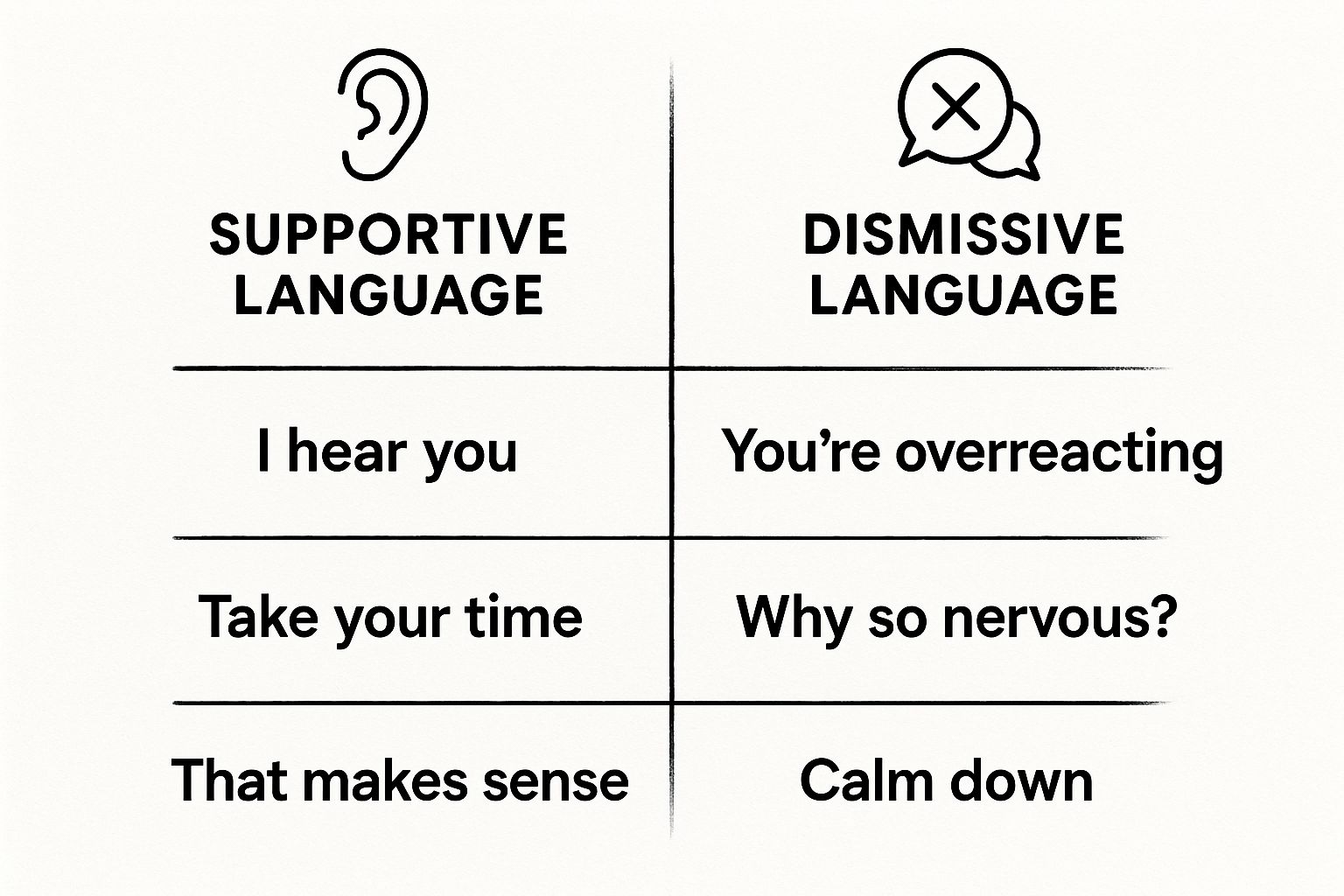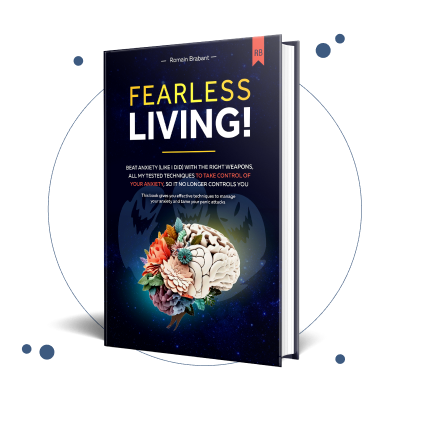
When you want to talk to someone about their anxiety, the best place to start is with empathy, patience, and a genuine willingness to listen without jumping to conclusions. Your goal isn't to fix them. It's to offer a safe space where they feel truly seen and heard, reminding them that healing is possible and a panic-free life is achievable. By using language that validates their experience and steering clear of dismissive phrases, you show them they’re not fighting this alone.
First, Understand Their Internal World

Before you even say a word, the most compassionate thing you can do is try to grasp what anxiety actually feels like from the inside. This isn’t about knowing a dictionary definition. It’s about appreciating the internal chaos—the racing thoughts, the disruptive physical symptoms, and a mind that’s stuck on high alert.
For someone with anxiety, their brain is often wired to perceive threats that aren't there, kicking off a primal survival response. This isn’t a choice or a character flaw. It's an involuntary reaction that can turn simple daily tasks into monumental challenges, leaving them feeling exhausted and isolated.
Why Well-Intentioned Advice Often Fails
Have you ever been stressed out and had someone tell you to "just relax" or "don't worry about it"? For a person with anxiety, these common phrases can feel incredibly invalidating. They suggest that anxiety is a simple choice that can be switched off at will, which completely minimizes the real physical and psychological battle they're fighting.
Telling someone to calm down when their heart is pounding and their mind is spiraling is like telling someone with a broken leg to just walk it off. It dismisses their reality and often makes them feel even more misunderstood and alone.
The most powerful thing you can offer is not a solution, but your presence. Your goal isn't to fix their anxiety, but to help them feel less alone with it. This shift in perspective is the foundation of every supportive conversation and a key part of their journey toward healing.
The Physical Reality of Anxiety
It's so important to remember that anxiety isn't just "in their head." The mental distress triggers a very real, very physical reaction in the body, often known as the fight-or-flight mechanism. You can get a deeper understanding of this by reading this detailed fight-or-flight response guide.
This primal response floods the body with stress hormones, leading to symptoms that are impossible to ignore:
- A racing heart or tightness in the chest
- Shortness of breath or a choking sensation
- Dizziness, trembling, or sudden sweating
- Nausea or intense stomach discomfort
When you understand that these physical sensations are just as real as the anxious thoughts, you build a bridge of empathy. Knowing what they’re actually experiencing equips you to offer genuine, non-judgmental support.
And most importantly, there is immense hope. With patience, the right support, and effective coping strategies, people absolutely can learn to manage their anxiety. Healing isn’t just possible; it's achievable. Your role as a supportive friend or family member can be a powerful part of that journey toward a more fulfilling, panic-free life.
Creating a Safe Space for Conversation

A good conversation about anxiety starts long before anyone says a word. It begins with creating an environment—both physically and emotionally—where the other person feels safe enough to be vulnerable. It's about laying a foundation of trust so they feel seen, not judged.
Your mindset is everything. Forget about trying to "fix" their anxiety. Go in with patience, compassion, and the simple goal of listening. When your only intention is to be there for them, the dynamic shifts from a stressful interrogation to a supportive connection.
Setting the Stage for Openness
Where and when you talk can make all the difference. Choosing a comfortable setting is one of the most considerate things you can do when learning how to talk to someone with anxiety.
- Find a private, calm location. Think about a quiet room at home or a peaceful spot in a park. Steer clear of busy coffee shops or public places where they might feel overwhelmed or worried about being overheard.
- Pick a low-stress time. Don't try to start this conversation when one or both of you are tired, rushed, or already on edge. A relaxed weekend morning often works far better than a chaotic weeknight.
This kind of thoughtful preparation sends a clear message: you value their feelings and you’re taking this seriously. It shows you care enough to dedicate a space just for them.
How to Start the Conversation Gently
This is often the trickiest part. The key is to be gentle and avoid anything that sounds like an accusation. Using "I" statements is a great way to express your concern from a place of care, which helps prevent them from feeling defensive.
For instance, instead of saying, "You've been acting really anxious lately," which can immediately put someone on guard, try a softer approach.
A better way to start: "I've noticed you seem to have a lot on your plate recently, and I've been thinking about you. I just wanted to check in and see how you're doing."
This simple tweak opens the door for them to share without feeling like they're under a microscope. It’s a powerful reminder that anxiety is a real and often disruptive condition. In the United States, nearly 1 in 5 adults has dealt with an anxiety disorder in the past year, and for many, it significantly impairs their daily life.
Knowing this isn't just a statistic; it’s a reason to lead with kindness. This conversation is an act of love, but it's also true that anxiety can strain even the strongest bonds. If you're supporting a partner through this, our guide on navigating https://anxietychecklist.com/love-vs-anxiety-relationship might offer some helpful insights.
By setting the stage with care, you're building the trust needed for them to open up, knowing you're right there with them on their path to recovery.
Knowing What to Say and What to Avoid
When someone trusts you enough to open up about their anxiety, the words you choose can either build a bridge or a wall. The goal isn't to fix them or offer a magic solution. It's to create a space where they feel seen, heard, and safe, reinforcing the hope that things can and will get better.
Honestly, the most powerful tool you have isn't brilliant advice—it's your presence and your willingness to just listen.
But listening is more than just staying quiet. It's about active listening—trying to understand the emotion behind the words. You can show you're really hearing them by reflecting their feelings back. Something as simple as, “It sounds like you're feeling completely overwhelmed right now,” can make a world of difference.
That small shift, from giving advice to offering validation, is incredibly healing. It signals that you're a safe person to talk to, someone who will simply be with them in the struggle instead of trying to rush them out of it.
Supportive Language That Builds Trust
Knowing how to talk to someone with anxiety often just means having a few supportive phrases in your back pocket. These aren’t scripts, but they communicate the empathy, patience, and unwavering support that are so vital for building trust and hope.
Effective phrases almost always focus on validation and presence.
- "I'm here for you, no matter what." This offers unconditional support without any pressure to perform.
- "Take all the time you need. There's no rush." This relieves the internal pressure they feel to "get over it" quickly.
- "That sounds incredibly difficult. Thank you for sharing that with me." This validates their struggle and shows you appreciate their vulnerability.
It’s amazing how a few simple word swaps can completely change the tone of a conversation from invalidating to empowering.

As you can see, it's about shifting from dismissal to connection.
Phrases to Avoid That Can Cause Harm
Just as important as knowing what to say is knowing what not to say. Even well-intentioned comments can come across as dismissive, shutting down the conversation and making the person feel even more alone.
Many of these conversational dead-ends come from a misunderstanding of anxiety. It's not a logical problem to be solved; it's a deeply felt emotional and physiological state.
Unhelpful phrases often try to minimize the person's feelings or rush them toward a solution they aren't ready for. The most supportive communication, in contrast, meets them exactly where they are without judgment, giving them the space they need to heal.
You'll want to steer clear of these common pitfalls:
- "Just calm down." This implies they can just switch it off, but a panic response isn't under conscious control. It can feel incredibly invalidating.
- "It's not a big deal." To them, it feels like a very big deal. This phrase dismisses their experience and can make them feel like they're overreacting.
- "You just need to think more positively." While positive thinking has its place, this oversimplifies the complex nature of anxiety and can feel like you're blaming them for their feelings.
A lot of these unhelpful reactions are tied to what are known as cognitive distortions—thinking patterns that aren't grounded in reality but feel very true in the moment.
To help you navigate these conversations, here’s a quick guide to choosing more supportive language.
Empathetic Phrases vs. Unhelpful Statements
A guide to choosing supportive language and avoiding common conversational pitfalls when talking to someone with anxiety.
| Instead of Saying This… | Try Saying This… | Why It Works |
|---|---|---|
| "Don't worry about it." | "That sounds really stressful. I'm here to listen." | It validates their feelings instead of dismissing them. It shows you're present. |
| "Just calm down." | "I'm right here with you. Take your time. Breathe with me." | It offers calm, shared presence, which is grounding. It doesn't demand control they don't have. |
| "It could be worse." | "That's a lot to handle. It's understandable that you feel this way." | It shows empathy and acknowledges the legitimacy of their struggle. |
| "You're overthinking it." | "What's on your mind? I'm here to hear it all, no judgment." | It invites them to share their thoughts without making them feel irrational or "wrong." |
| "Let me know if you need anything." | "Can I get you a glass of water, or would you prefer I just sit with you?" | It provides specific, actionable support, which is much more helpful than a vague offer. |
Ultimately, the goal isn't to have the "perfect" response every single time. It's about showing up with a compassionate, open heart. Your consistent, non-judgmental presence sends the most important message of all: they are not alone, and healing is possible.
Navigating Panic Attacks and High-Stress Moments

Sometimes, a conversation about anxiety doesn’t happen over a calm cup of coffee. It happens right in the middle of a crisis. Supporting someone through a panic attack or an intensely stressful moment calls for a different, more immediate kind of help.
In these critical moments, your calm and steady presence is the most powerful tool you have.
A panic attack is a sudden, overwhelming wave of fear that triggers severe physical reactions, even when there's no real danger. It can feel absolutely terrifying—often mimicking the symptoms of a heart attack—which is why your composed response is so vital. Your goal isn't to stop the attack, but to be a safe anchor until it passes.
And it will pass. That's the most important message you can offer. Gently remind them that even though the feelings are overwhelming, they are temporary and not dangerous. Your presence alone is a powerful sign that they aren't alone and that they will get through this.
Practical In-the-Moment Support
When someone is in the grips of high stress, their brain isn't wired to process complex information. The key is to keep your communication simple, direct, and deeply reassuring. Stick to short, calm sentences, and avoid flooding them with questions or complicated instructions.
Your main job is to help them feel safe. Here's how:
- Stay with them. Unless they specifically ask for space, just being there can be incredibly grounding.
- Speak calmly. Use a low, soothing tone of voice.
- Offer simple reassurances. Phrases like, "You are safe," "I'm right here with you," and "This feeling will pass" are surprisingly effective.
The experience of a panic attack can feel isolating and frightening. By staying present and calm, you provide a non-verbal message of safety and hope, reinforcing their ability to overcome the moment and, eventually, find a path to a panic-free life.
Introducing Grounding Techniques
As the initial peak of the panic starts to fade, you can gently introduce a grounding technique. These are simple exercises designed to pull their focus away from overwhelming internal feelings and back to the present moment, using their senses. This isn't about fixing them; it's about offering a tool that gives them back a sense of control.
You could softly suggest the "5-4-3-2-1" method:
- 5: Ask them to look around and name five things they can see.
- 4: Have them acknowledge four things they can physically feel (like their feet on the floor or the texture of their shirt).
- 3: Ask them to listen for three things they can hear.
- 2: Have them name two things they can smell.
- 1: Finally, ask them to name one thing they can taste.
This simple sensory exercise helps shift their focus outward, which has a calming effect on the nervous system. There are many other great approaches, and you can explore more in this guide to grounding techniques for anxiety. By learning a few of these, you're equipping yourself to offer real, actionable help that reminds them they have the strength to manage these intense moments.
Encouraging Next Steps and Offering Lasting Support
Having that first conversation is a huge step, but it’s just that—a first step. Real support doesn’t end when the talk is over. It’s about sticking around for the long haul.
Your next move is to gently encourage them toward healing while making one thing crystal clear: you believe they have the strength to get through this. You’re not there to fix them or be their therapist. You’re there to be a steady, hopeful presence who celebrates the small wins and never loses faith in their ability to get better.
Gently Suggesting Professional Help
Bringing up therapy can feel like walking on eggshells, but it's one of the most powerful ways you can show you care. The trick is to frame it as an act of strength, not a sign that something is "wrong" with them.
Instead of saying something blunt like, "You really need to see a therapist," which can sound like a judgment, try a softer, more collaborative approach.
"I can see how much this has been weighing on you, and I’m so glad you shared it with me. I’ve heard that talking to someone who specializes in this can make a huge difference. Would you be open to us looking into that together?"
The logistics of finding help can feel like climbing a mountain for someone already struggling with anxiety. Offer to take some of that weight off their shoulders. You could help research local therapists, sit with them while they make the first call, or even drive them to an appointment and wait in the lobby. These small acts show you’re genuinely in their corner.
If they're open to the idea, learning more about different approaches, like what psychotherapy for anxiety actually involves, can make the whole process feel less intimidating.
Acknowledging Barriers and Offering Hope
Let’s be real: getting help isn’t always easy. Globally, anxiety touches the lives of over a billion people, but stigma, cost, and a sheer lack of access mean only about 27.6% of those with anxiety disorders actually receive treatment.
By simply acknowledging these hurdles, you can lift a huge weight of shame off their shoulders. You’re not just offering support; you’re creating a space where it feels possible to hope for something better. You can learn more about this treatment gap from this in-depth research on global mental health.
Maintaining Your Own Well-Being
Supporting someone you care about is a marathon, not a sprint. To be the consistent ally they need, you have to protect your own emotional and mental energy.
Set gentle boundaries to keep yourself from burning out, and make sure you have your own support system to lean on. For long-term wellness, you can also gently encourage them to explore things that support overall mental health, like understanding the profound connection between sleep and mental health.
Remember, you can’t pour from an empty cup. The greatest gift you can offer is your own steady, healthy presence on their path to recovery.
Questions You Might Be Asking
When you're trying to support someone through anxiety, it’s natural to have questions. You might wonder how to handle tricky situations, what to do if they push back against getting help, or even how to look after your own mental health in the process. These are all completely valid concerns.
Let's walk through some of the most common questions that come up when you're figuring out how to be there for someone with anxiety.
The goal isn't perfection. It's presence. Healing from anxiety and living a life free from panic is absolutely possible, and your steady, hopeful support can be a huge part of that journey.
What If They Don’t Want to Talk About Their Anxiety?
If someone isn’t ready to open up, the single most supportive thing you can do is respect that. Pushing someone to talk before they're ready can backfire, making them feel even more pressured and anxious.
Instead of pressing, just let them know the door is open. Try saying something gentle and without expectation, like:
"I get it. Just know I'm here to listen, without any judgment, whenever you feel ready. I care about you, and I'm not going anywhere."
You can still be supportive in other ways that don't involve a big, heavy conversation. Invite them to do something low-key, like watching a movie or going for a quiet walk. Sometimes, simply sharing space without the pressure to talk is the most powerful support you can offer.
How Can I Help If They Refuse to Seek Professional Help?
This is a tough spot to be in. You can see how much professional help could change things, but your loved one just isn't there yet. Remember, you can't force anyone into therapy, but you can be a source of gentle encouragement and hope.
Your role here is to be a supportive ally, not the manager of their mental healthcare. Here are a few things that might help:
- Normalize getting help. Casually mention positive stories you’ve heard about therapy or share helpful articles from trusted sources. This helps chip away at any stigma they might be feeling.
- Suggest smaller steps. Instead of jumping straight to therapy, you could suggest something less intimidating. Maybe a guided meditation app, an anonymous online support group, or just bringing up how they've been feeling with their regular doctor.
- Keep validating their feelings. The more they feel understood and accepted by you, the less shame they're likely to feel about their struggles. Your validation can be the bridge that eventually leads them to seek professional support.
Am I Making Things Worse by Talking About It?
This is such a common fear, but let’s clear it up: talking about anxiety in a supportive, non-judgmental way almost never makes it worse. In fact, the opposite is often true. Avoiding the topic can make the other person feel more ashamed and isolated.
Harm doesn't come from talking about anxiety; it comes from how you talk about it. Being dismissive ("Just relax!"), offering a string of unsolicited advice, or minimizing what they're feeling—that's what causes damage.
When you focus on listening more than you speak, validating their experience, and simply offering your presence, you’re sending a clear message: they are not alone. Your support is a powerful, positive force on their path to healing.
The journey toward a panic-free life is possible, and having the right tools can make all the difference. At The Anxiety Checklist, we've developed a practical, self-help system to empower individuals with the strategies needed to manage anxiety and regain control. Explore our resources and start building your personalized toolkit today at https://anxietychecklist.com.

